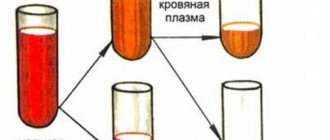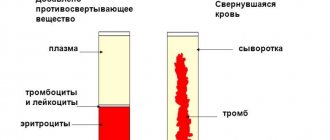What is osmotic pressure and how does it affect the human body
Osmosis occurs in the human body at the boundary of two different solutions separated by a semi-permeable membrane. One liquid has the ability to penetrate through the walls into the second, which has already been exposed to the first.
Using the example of the human body, we can show the nature of osmotic pressure: water passes through the membrane and enters the blood. Plasma contains a certain concentration of mineral salts, glucose, and proteins. The osmotic pressure indicator lets you know whether the body is sufficiently provided with the exchange of water between the bloodstream and the organs that are located on the outside of the vessels. Osmotic pressure in the human body is the amount of force that forces water to move through the protective membrane of red blood cells.
It is mainly salt that affects osmosis in the blood plasma, because it contains proteins, sugar and urea in small quantities.
The optimal concentration of saline solution in the bloodstream should be 0.9%. This indicator is called isotonic. It is equal to the amount of blood osmosis. When the value exceeds this indicator, the osmotic pressure becomes hypertonic. If this figure is lower, it is hypotonic. In order for the human body to function normally, osmotic pressure must be within optimal values.
It is clear that the osmosis rate cannot be constant, but if the salt concentration is increased or decreased for a short time, then a healthy excretory system can easily remove excess fluid, saline solutions and other substances. In this case, the body itself takes care of the presence of the correct amount of salt inside it. When a person’s health fails and the osmotic pressure is either low or high for a long period, this can cause the occurrence of certain diseases.
Among the most likely consequences is hemolysis. This is a condition in which the membranes of red blood cells burst and they dissolve in the liquid. The appearance of blood containing such dead red cells is slightly transparent. If the parameters of the osmosis force are far from optimal, then the elasticity of cells, tissues and entire organs will disappear. Both with increased osmotic pressure and with decreased pressure, red blood cells have the same fate - destruction.
Which indicators are considered normal and which are considered deviations from the norm?
During this examination of the blood, its freezing point is found. The optimal value for a blood solution is minus 0.56-0.58 degrees. If converted to atmospheric pressure, then normal indicators of the strength of osmosis are 7.5-8 millimeters of mercury. If the indicator is either greater or less than the specified limits, its value will be a deviation from the optimal one.
Proteins, like salts, also create plasma osmotic pressure, but weaker in comparison (its value is 26-30 millimeters of mercury). This pressure is also called oncotic pressure, and it changes the value of the overall indicator.
Dry eyes caused by contact lenses
Type: Exosmos
Do you know why we put contact lenses in saline solution? Why not clean water? This is because saline contact lens solution contains the same concentration of salt water as your eye.
When you keep your lenses in the solution, they stay moist, soft and comfortable. Otherwise, they tend to absorb moisture from the eyes through osmosis as they lose water during wear.
What affects osmosis rates
The strength of osmosis is influenced by proper nutrition and drinking regime, as well as the healthy functionality of the excretory organs. The amount of salts in the plasma directly affects osmotic pressure. With an excess of them, osmosis will increase, and with a deficiency, it will decrease.
And the rate of fluid intake should be at least 1.5 liters per day, otherwise the body will become dehydrated and the blood will gain increased viscosity.
But, fortunately, when there is a shortage of fluid, a person becomes thirsty and replenishes his water supply. The work of the kidneys, bladder and sweat glands also regulate the amount of salts and solvent in the body, but if the increased concentration of salt is constant, this provokes its retention in the cells. Then the walls of the vessels become thicker, and the lumens of the intercellular space narrow.
As a result, fluid retention occurs, which leads to an increase in the volume of blood moving through the vessels, which provokes an increase in blood pressure. All this negatively affects the functioning of the cardiovascular system and causes the appearance of edema.
Plants absorb water from the soil
Type: Endosmos
While plants absorb water throughout their entire surface (leaves, stems and roots), most of the water is absorbed by the root hairs. These root hairs act as a semi-permeable barrier, allowing water molecules (solvent) to move from high concentration (soil) to low concentration (roots).
As a result, root hair cells become more swollen, and their osmotic pressure (ability to absorb solvents) drops.
Water molecules then move into tubes called xylem vessels and are transported to the leaves. Within xylem cells, water molecules exert a strong influence on each other through hydrogen bonds. As water evaporates through the stomata (tiny pores on leaves), more water is released through the xylem cells of the root to replace what was lost.
Measurement methods
There are two most widely used methods for measuring osmosis pressure. Doctors choose which one to use based on the situation.
Cryoscopic method
Since the freezing point of blood directly depends on the amount of substances in it, this method is often used. The more saturated the plasma, the lower the temperature it solidifies. The osmosis indicator is an important parameter in the functioning of the body, and it shows whether the solvent (water) is present in it in optimal quantities.
Osmometer measurement
The second measurement option suggests doing this using a special device - an osmometer. It consists of 2 flasks with a partition. The passage between them is partial.
Blood is poured into one of them and covered with a lid with a scale, and solution into the other. It can be hypertonic, hypotonic or isotonic. Look at the scale readings in the vessel.
Haller's equation[ | ]
The experimentally determined value of the osmotic pressure of high-molecular compounds is greater than the theoretical one, determined by the Van't Hoff formula π = c RT {\displaystyle \pi =cRT}. This phenomenon is explained in the relative independence of the thermal motion of each part of the macromolecule and is described by the Haller equation:[1]
π = RTM c + β c 2 {\displaystyle \pi ={\frac {RT}{M}}c+\beta c^{2}}
Here: c {\displaystyle c} is the concentration of a solution of a high-molecular compound (g/l), M {\displaystyle M} is the molar mass (g/mol), β {\displaystyle \beta } is a coefficient that takes into account the flexibility and formula of the macromolecule in solution, R is the universal gas constant, T is the thermodynamic temperature of the solution.
At small values of concentration c {\displaystyle c} Haller's formula transforms into Van't Hoff's formula.
Normalization methods
The human body has the ability to self-regulate osmotic pressure. When a corresponding impulse is received from the brain to reduce the volume of intercellular fluid, a hormone is formed that enters the blood. Then the kidneys react to its presence.
Blood also has the ability to bring osmotic pressure parameters to optimal values, acting as a buffer device both when the pressure associated with osmosis increases and when it decreases.
This occurs due to the redistribution of ions between the blood plasma and red cells, and the “ability” of proteins in the blood to attach or release ions.
Food canning
Type: Exosmosis (bacterial cells lose water)
The reason we can enjoy jams and pickles for a long time without fear of spoilage is osmosis. Both are concentrated foods containing large amounts of sugar (in the case of jams), salts, oils, vinegar and other spices (in the case of pickles).
They act not only as flavor enhancers, but also as excellent preservatives, killing bacteria and preventing the growth of other harmful microorganisms.
High concentrations of sugar and salt have a hypertonic effect on bacterial cells. Bacterial cells lose water due to higher concentrations outside and become less conductive to support microbial growth.
Preventive methods
The regulation of the force of osmosis is influenced by the kidneys. If the body needs additional fluid, then the saturation of the blood with active substances will be excessive, and this provokes an increase in pressure. Therefore, you need to be attentive to your feelings, and if thirst arises, it must be quenched immediately.
You should also adhere to proper nutrition:
- Monitor the amount of salt in food. Oversalting and excessive use of spices can lead to a decrease in the permeability of blood vessels due to the presence of salt deposits on their walls.
- Limit drinks such as coffee, Coca-Cola, beer. They can provoke red blood cells to stick together and have a diuretic effect, that is, they actively remove fluid from the body.
- You need to give up various diets and fasting. These experiments on oneself lead to a decrease in the level of proteins in the blood, and this changes the viscosity of the blood and contributes to the occurrence of thrombosis, causes exhaustion and a feeling of fatigue, and a person’s defenses decrease.
The power of osmosis in the human body is responsible for the optimal redistribution of fluid, because the amount of active substances must be at a certain level. This is a very important indicator that illuminates the state of health. In order for its values to be within normal limits, it is useful to drink more water and add salt to food in moderation.
Justification of the van't Hoff formula from a thermodynamic point of view[ | ]
In solution, free energy G = G 0 + RT ln x A + π VC {\displaystyle G=G^{0}+RT\ln x_{A}+\pi V_{C}} , where x A {\displaystyle x_{A}} is the molar part of the solution, VC {\displaystyle V_{C}} is its molar volume. The appearance of the term π VC {\displaystyle \pi V_{C}} is equivalent to introducing external pressure into the free energy. For a pure solvent, G = G 0 {\displaystyle G=G^{0}} . At equilibrium, ∇ G {\displaystyle \nabla G} for the solvent is zero. Thus,
0 = ∇ G = G 0 + RT ln x A + π VC − G 0 = RT ln x A + π VC , {\displaystyle 0=\nabla G=G^{0}+RT\ln x_{A }+\pi V_{C}-G^{0}=RT\ln x_{A}+\pi V_{C},}
where:
π = − RTVC ln ( 1 − x B ) ≅ RTVC x B ≅ RTVC n B n A ≅ RT n BV = c RT , {\displaystyle \pi =-{\frac {RT}{V_{C}}} \ln(1-x_{B})\cong {\frac {RT}{V_{C}}}x_{B}\cong {\frac {RT}{V_{C}}}{\frac {n_{ B}}{n_{A}}}\cong RT{\frac {n_{B}}{V}}=cRT,}
that is, the Van't Hoff formula is obtained ( π = c RT {\displaystyle \pi =cRT} ).
When deriving it, it was calculated that x B {\displaystyle x_{B}} is a small value. This allows us to expand ln ( 1 − x B ) {\displaystyle \ln(1-x_{B})} into a series and then apply the relation x B ≅ n B n A . {\displaystyle x_{B}\cong {\frac {n_{B}}{n_{A}}}.} The product n AVC {\displaystyle n_{A}V_{C}} in dilute solutions is almost equal to the volume of the solution.











